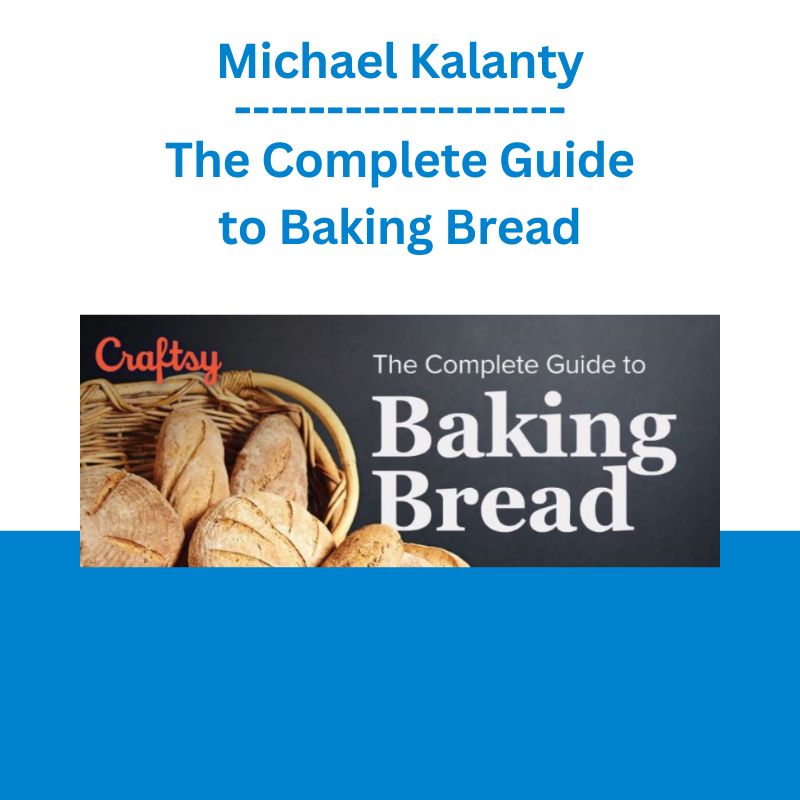*** Proof of Product ***
Exploring the Essential Features of “Michael Kalanty – The Complete Guide to Baking Bread”
The Complete Guide to Baking Bread
Professional chefs share the secrets to making exceptional breads from scratch-and you can learn to make them in your own home.
LESSON
Trailer
01:The Ecosystem of Bread
While you’ve used many words to describe bread over your lifetime, you’ve probably never used “ecosystem.” And yet, as Chef Kalanty explains, bread is exactly that—an ecosystem supporting one living organism: single-celled yeast. Learn the appropriate protocol for creating dough and the FATTOM constituents of this environment: food, acid, time, temperature, oxygen, and moisture.
27 min
02:The Chemistry of Gluten
Discover the important role of gluten, the protein that gives the dough its elasticity and shape. Learn how it develops in the dough and what causes dough to become sticky. Experiment with the dough’s moisture content to determine how that affects gluten development and subsequent bread shape and texture.
24 min
03:Fermentation Civilization
Learn about the conditions that cause yeast to start and stop fermentation as part of the organism’s natural life cycle. Discover how yeast creates carbon dioxide and how you can influence that production by using water to change the dough temperature. Chef Kalanty also illustrates how fermentation affects the crumb of the finished product.
21 min
04:Shaping Physics
You’ll be surprised to discover how your posture, table height, and the force you apply to the dough all affect the bread’s gluten elasticity and carbon dioxide content. Follow Chef Kalanty as he shows how to create first-form options and then the final shapes for baguettes, bâtards, dinner rolls, and knots.
28 min
05:Why Do We Proof?
After creating your final shapes, but before baking, the dough is proofed, a resting period during which the yeast is left to create more carbon dioxide. Learn how to develop an appropriate proofing environment in your kitchen using your dishwasher, kitchen cabinet, or second oven as you manage the humidity, temperature, and timing of the yeast environment to create the desired bread structure.
17 min
06:Inside the Bake
Learn about the three stages of baking and why the bread must ripen before eating. Watch Chef Kalanty as he demonstrates how scoring the top of the dough affects the bread’s expansion and ultimate shape as gases escape during the first phase of baking, oven spring.
28 min
07:The Master Recipe
Learn how to make an all-in-one-bucket dough that can stay in your refrigerator for up to two weeks while you cut pieces off to make breads, flatbreads, and dessert rolls. Follow Chef François as she builds the master recipe from the basics: water, salt, yeast, and flour.
17 min
08:Boule Variations and Slow Cooker Bread
Using dough from the master recipe, learn to make a couronne, a traditional circular bread, this time with embedded olives, as well as a delicious cheddar cheese bread. You’ll also experiment with baking bread in a Dutch oven and a slow cooker.
16 min
09:Baguettes
Chef François demonstrates how to make the classic baguette, the long, thin bread of France known for its soft interior and crunchy exterior. Learn how the stretching, relaxing, and shaping of the dough all affect the final product. In addition, you’ll learn to make the traditional epi, using kitchen shears to shape the baguette dough, and wreath bread.
24 min
10:Sandwich Breads, Buns, and Rolls
Learn a simple way to make a tasty sandwich bread with very little dough work. Chef François also demonstrates how to make a delicious sandwich-shaped loaf swirled through with apples and cinnamon sugar. For smaller breads, you’ll be surprised how easy it is to make individual buns, pull-apart rolls, and crescent rolls.
18 min
11:Pita and Naan
Although naan is traditionally cooked on the side of a super-heated tandoor oven, Chef François demonstrates how to make this quick flatbread in both a stove-top skillet and on a cooking stone in a preheated oven. You’ll also learn how to make pita, both as a bread and as a crispy cracker bowl in which you can serve a variety of other foods.
18 min
12:Pizza and Focaccia
Have you ever wondered how and why pizza chefs twirl their dough high in the air? You’ll learn that and more as Chef François prepares a classic Neapolitan pizza, sauce and all; a cracker-crust pizza with apples, pine nuts, and honey; and a Sicilian sheet-pan pizza with numerous toppings. You’ll also learn to make a delicious focaccia in a round cake pan.
23 min
13:Stuffed Breads
If you love both savory and sweet, you’re in luck! Learn a simple way to make an elegant spinach-and-feta stuffed bread, sweet pinwheels, cinnamon buns, and caramel rolls. Although the dough itself is not sweet, you’ll discover how to use butter, sugar, cheese, jelly, and more to create these various delights.
28 min
14:Getting Started with Whole Grain Baking
Chef Kalanty reviews key bread ingredients and provides an overview of the language of baking. As you tackle a honey whole wheat sandwich bread, you’ll gain valuable tips about desired dough temperature and learn how to prepare your mise en place.
24 min
15:Dough Development and Fermentation
Discover the importance of dough hydration as you develop the dough’s structure through kneading. Chef Kalanty also demonstrates how fermentation creates flavor and shows you ways to increase the bitterness of your breads.
23 min
16:Shaping, Proofing, and Baking
Fitting your bread into loaf pans for proofing can be a challenge. As you prepare it for baking, Chef Kalanty explains each stage, provides some tasty tips before it goes in the oven, and reveals how to evaluate a finished loaf.
22 min
17:Raisin Whole Wheat Swirl Bread
Bringing a little sweetness to this section, Chef Kalanty demonstrates how to incorporate solid ingredients and roll the dough so your bread bakes evenly. Because adding ingredients can add a challenge to baking, Chef Kalanty also breaks down the whole wheat structure.
26 min
18:Rustic Whole Wheat Boule
Starting with a lesson on how to soak whole wheat berries in order to release the nutrients and soften them, step by step, you’ll follow Chef Kalanty as he forms a boule shape, uses proofing baskets, and bakes on stone in order to create a rustic boule.
29 min
19:Multi-Seed Bâtard
Revisiting the steps to soak seeds and grains, you’ll apply what you’ve learned to multigrain bâtard, which incorporates a pre-fermenting phase that will add to the structure and flavor of this robust bread. Chef Kalanty demonstrates how to use a couche—a linen proofing cloth—for this long-lasting loaf.
37 min
20:Multigrain Boule
Using techniques from previous lessons—including soaking grains, pre-fermenting, and developing the dough—Chef Kalanty will walk you through creating a beautiful multigrain loaf and demonstrate how you can easily experiment with variables to develop both your skills and palate.
21 min
21:Introduction
Sourdough bread is different than yeasted breads. Chef Miscovich explains why as you look into the science of natural fermentation and create, grow, and feed a sourdough starter.
20 min
22:Making Pain au Levain
Learn how to use your starter to create a preferment—or levain—which is the leavening agent that is the base of your sourdough. Chef Miscovich demonstrates a traditional French cutting method, as well as several ways to knead your dough, as he reveals the autolyze method, which results in strong gluten bonds.
25 min
23:Baking Pain au Levain
Find creative alternatives to a cloche if you don’t have one, as well as easy ways to create steam in your home oven, as Chef Miscovich takes you through the steps of resting, shaping, scoring, and baking your sourdough.
28 min
24:Pain au Levain Variations
Take your newfound lessons in traditional sourdough bread to the next level as you experiment with three variations: olive focaccia, rosemary fougasse, and olive fougasse. Here, Chef Miscovich will show you tips to overcome the challenge of keeping a balance to the dough formula as you add in new ingredients.
14 min
25:Going Whole Grain
With an eye on healthy eating, this lesson looks at how whole grains affect hydration in dough and how to vary your technique if you want to create a heartier, healthier loaf with an increased whole grain content by sprouting whole wheat berries before adding them to your mix.
19 min
26:Something’s Gone A-Rye
Discover the joys of rye bread, and its Danish cousin Rugbrød. Chef Miscovich demonstrates how to use a stand mixer and which techniques are different when you add rye flour to your dough.
24 min
DETAILS
Overview
There is almost no smell as comforting, as universal, or as mouth-watering as that of freshly baked bread. The most recent research shows we started eating bread 14,000 years ago, so it’s hard to know whether the way bread affects us is that of a Pavlovian response “baked” into our evolution as a species, or if it just really does smell that delicious.
About
Michael Kalanty
The world of bread sustains life and celebrates the passage through it.
Chef Michael Kalanty—The Art and Science of Bread & Secrets to Whole Grain Bread Baking—has more than 20 years of baking and cooking experience. He is a published author who teaches at the International Culinary School and is the director of education for the California Culinary Academy.
Zoë François
I’m Zoë François and I love to bake. This is where I play with sugar and take the mystery out of baking everything.
Chef Zoë François—Artisan Bread in Minutes—is a best-selling author, coauthor of several bread cookbooks, and a renowned blogger. She’s a seasoned baking instructor and frequent contributor to The Cooking Channel, Fine Cooking magazine, and Disney Channel.
Richard Miscovich
I live my dream everyday – baking the best artisan breads and pastries using the same old-world techniques that make artisan baking so unique.
Chef Richard Miscovich—Handmade Sourdough: From Starter to Baked Loaf—is a published author who currently serves as an assistant professor at Johnson & Wales University, where he teaches bread production. He was the recipient of the Baking & Pastry Service Award in 2006 and 2009.
REVIEWS
Paradoxpointer
Disappointing
Very simplistic and off-putting corny style. Not up to TGC standards.
Jim83
Merritt Island FL
Baking Bread
I learned a lot so far. New way (to me) they use is to make a large basic recipe that can be saved in the fridge and used several times. I also bought a cutter and a Danish mixer.
Please see the full list of alternative group-buy courses available here: https://lunacourse.com/shop/










 Racing Workshop - Complete Online Package
Racing Workshop - Complete Online Package  SMB - Options Training
SMB - Options Training